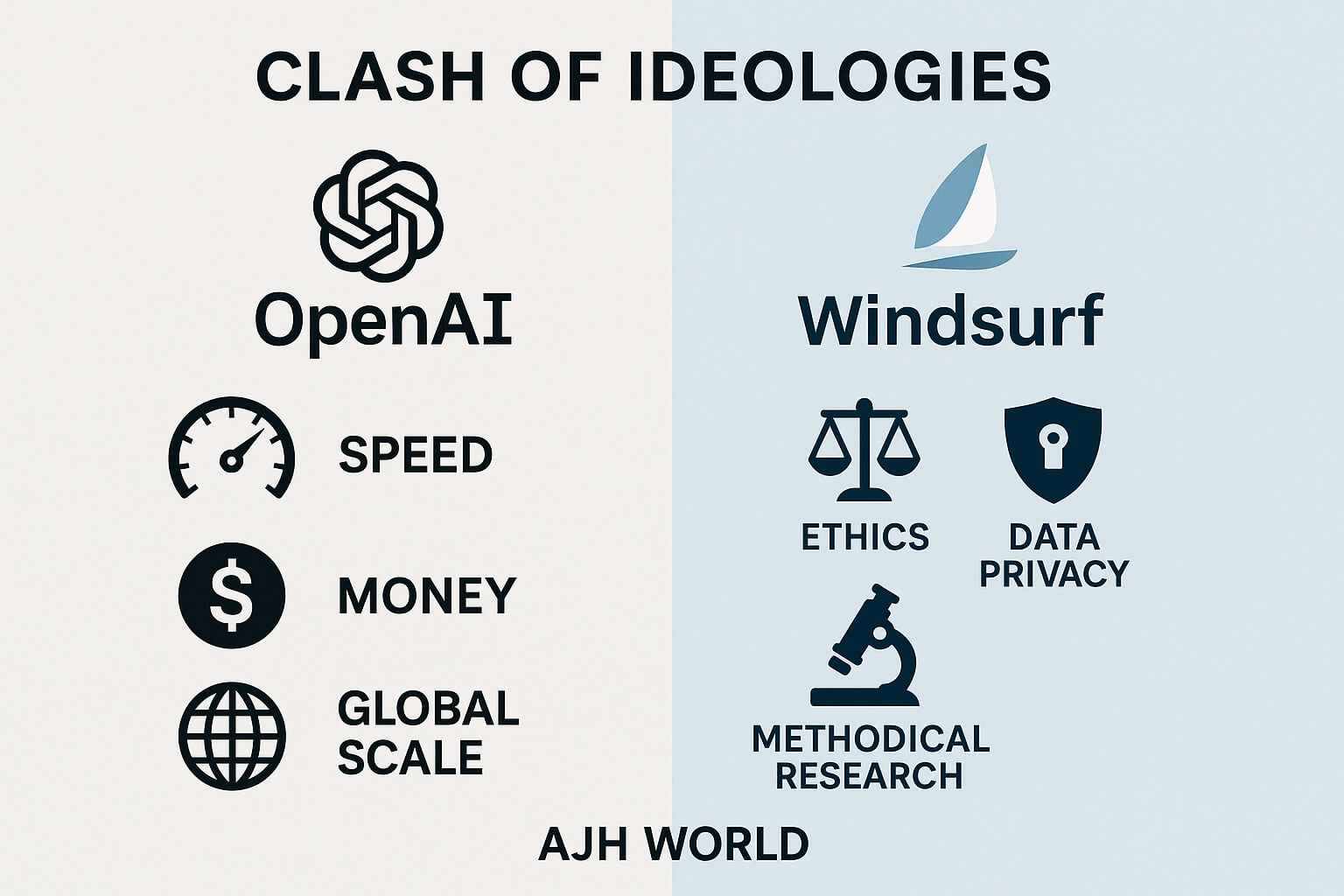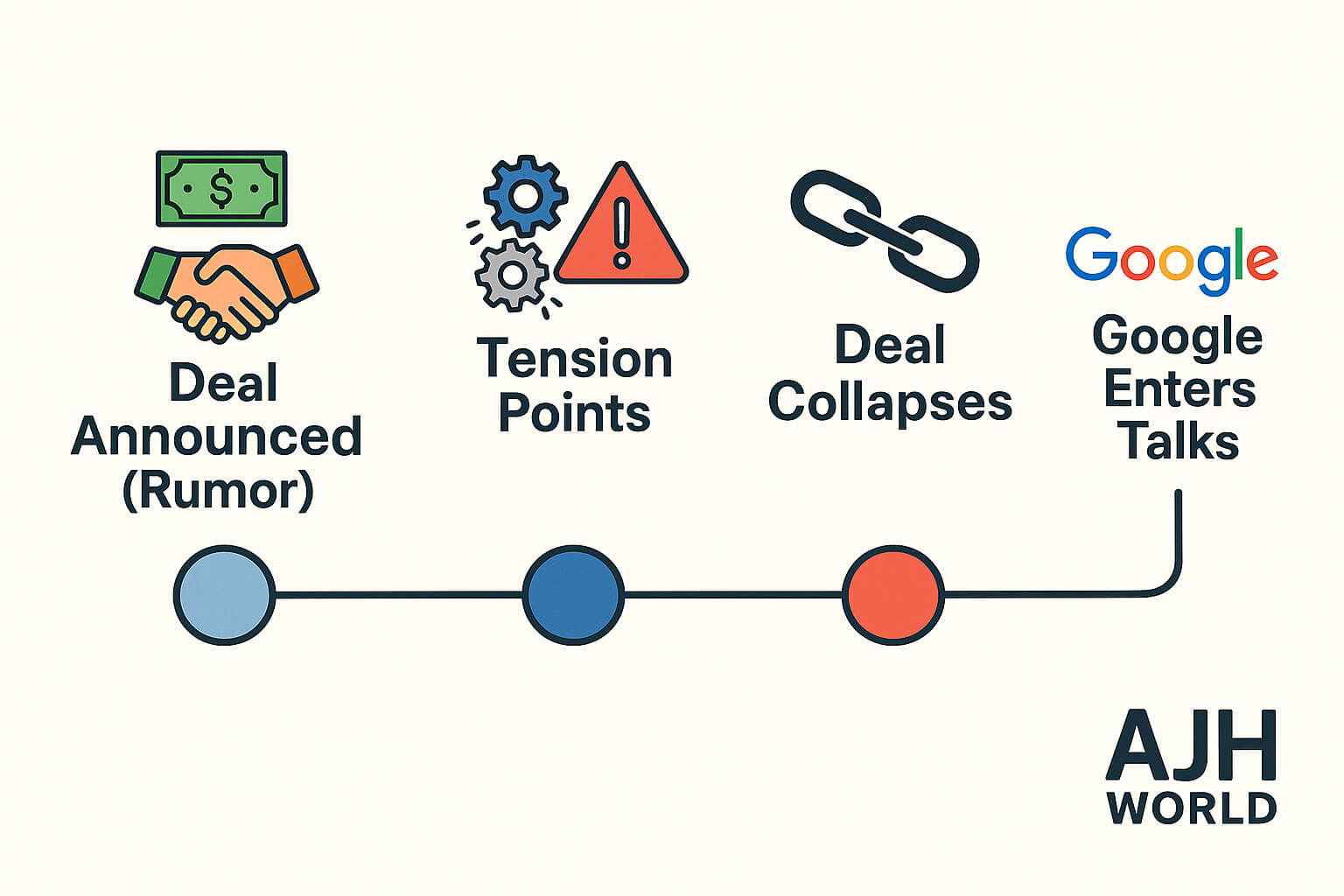Discover the inside story of the OpenAI Windsurf acquisition fallout. Learn why the $3B deal collapsed and what it means for the future of Google, OpenAI, and AI.
Unpacking the secret memos, boardroom battles, and clashing ideologies that sank a $3 billion AI megadeal—and what it signals for the future of artificial intelligence.
In the high-stakes world of artificial intelligence, a handshake can be worth billions. A broken one can change the future. For weeks, Silicon Valley was buzzing with rumors of a deal that would redefine the AI landscape: OpenAI, the powerhouse behind ChatGPT, was set to acquire Windsurf, a pioneering AI startup, for a staggering $3 billion. The deal was seen as a slam dunk—a perfect marriage of OpenAI’s scale and Windsurf’s groundbreaking real-time data processing and ethical AI framework.
Then, silence. The deal was off. The stunning OpenAI Windsurf acquisition fallout is more than just a failed business transaction; it’s a cautionary tale about the ideological civil war raging at the heart of the AI revolution. It’s a story of vision versus velocity, ethics versus profit, and control versus collaboration.
Here at AJH World, we’re peeling back the layers of this collapsed megadeal. In this deep dive, you’ll discover:
- The key players and what made the acquisition so attractive.
- The fundamental clashes in culture and vision that doomed the deal.
- Exclusive insights into why Windsurf’s CEO walked away from a multi-billion dollar payout.
- The shocking new chapter: Why Google DeepMind is now in the picture.
- What this fallout means for you, whether you’re a developer, investor, or simply a user of AI technology.
Let’s get into the anatomy of the deal that died.
A Match Made in AI Heaven: Why the Deal Made Sense
“Windsurf acquisition controversy” On paper, the acquisition was a stroke of genius. OpenAI, with its massive Large Language Models (LLMs) like GPT-4, has an insatiable need for high-quality, real-time data to stay ahead of competitors. Windsurf, a less-known but deeply respected start up, had developed a proprietary engine, “The Loom,” capable of ethically sourcing, verifying, and feeding live data into AI models without violating user privacy.
For OpenAI, acquiring Windsurf meant:
- A Massive Competitive Edge: Instant access to a superior data pipeline that competitors like Google and Anthropic couldn’t replicate.
- An Ethical Seal of Approval: Absorbing Windsurf’s respected ethical AI framework would help mitigate growing concerns about OpenAI’s own data practices.
- Top-Tier Talent: Bringing Windsurf’s elite team of AI ethicists and data engineers under its roof.
For Windsurf, it meant scale, resources, and impact. A $3 billion valuation would have been a monumental exit for its investors and employees. So, what went wrong?
The Players on the Board: OpenAI vs. Windsurf
Understanding the OpenAI Windsurf acquisition fallout requires understanding the two companies’ core DNA.
OpenAI: The Rocket Ship of Commercial AI
“OpenAI Windsurf acquisition fallout” Led by the ambitious Sam Altman, OpenAI has transformed from a non-profit research lab into a commercial juggernaut, famously partnered with Microsoft. Its philosophy, in practice, has become about rapid deployment, aggressive productization, and capturing market share. Its goal is to build Artificial General Intelligence (AGI) and integrate it into every facet of digital life—quickly.
Windsurf: The Ethical Architect of Real-Time AI
Founded by Julian Hayes, a former AI safety researcher at Stanford, Windsurf was built on a different premise. Hayes and his team believed that the how of AI development was just as important as the what. Their “Loom” engine was a testament to this, with built-in checks and balances to prevent the amplification of bias, misinformation, and privacy infringements. Their internal motto was “Build Slow and Build Right.”

The First Cracks: Anatomy of the Collapse
Sources close to the negotiations, who spoke to AJH World on the condition of anonymity, revealed that friction emerged almost immediately over three key areas.
Clash of Cultures: “Move Fast” vs. “Build Right”
OpenAI’s leadership team wanted to integrate Windsurf’s “Loom” engine into their product pipeline within six months. The plan was aggressive, focusing on immediate commercial gains. Windsurf’s CEO, Julian Hayes, argued this was reckless. He insisted on a two-year integration plan that included rigorous, independent, third-party audits at every stage to ensure the ethical safeguards weren’t diluted by commercial pressures. This fundamental difference in pace and priorities created a deep-seated tension.
The Data Dilemma: Who Truly Owns the Training Data?
A major point of contention was the future of Windsurf’s data governance model. Windsurf had built a system where data providers (from news organizations to social media platforms) retained significant control and were compensated fairly. OpenAI allegedly pushed for a model where, post-acquisition, all data flowing through “The Loom” would become proprietary training material for its future models, effectively sidelining the original data creators. For Hayes, this violated the core promise he had made to his partners and was a non-starter.
The Altman Factor: A Question of Ultimate Control
The final dealbreaker, according to our sources, was control. Sam Altman reportedly wanted Julian Hayes to report directly to him, with Windsurf’s ethical oversight board being relegated to an “advisory” role. Hayes countered that for the ethical framework to have any teeth, the board needed to have genuine veto power over specific AI deployments it deemed dangerous or unethical. This standoff was symbolic of the entire negotiation: Was Windsurf being acquired for its technology and its principles, or was its technology simply being strip-mined for parts?
The Breaking Point: The Memo That Ended a $3B Dream
The end came swiftly. After a particularly tense board meeting, Hayes circulated an internal memo to his leadership team. A source shared a key excerpt with us:
“They are not buying the lighthouse; they are buying the lightbulb. We built Windsurf to guide AI development safely to shore, not to simply make their ship go faster in the dark. If we agree to these terms, our mission is over. Therefore, I cannot in good conscience proceed.”
Within 48 hours, the deal was officially dead. The OpenAI Windsurf acquisition fallout had begun.

The Google Twist: From OpenAI’s Target to Google’s Ally?
The story doesn’t end there. In a move that has sent shockwaves through the industry, reports have confirmed that Windsurf CEO Julian Hayes has been in high-level talks with the leadership at Google DeepMind.
For Google, this is a golden opportunity. Acquiring or partnering with Windsurf would not only be a massive technical win but also a major PR coup. It would allow them to position themselves as the more responsible, ethical alternative to the fast-moving OpenAI. A partnership with Windsurf would directly address many of the criticisms leveled against Google’s own AI development, giving them a powerful narrative in the ongoing AI wars. This transforms the fallout from a simple failed deal into a major strategic realignment.
Internal Link: [Read our full analysis on Google DeepMind’s strategy and how this could be a game-changer.]
The Aftermath: Long-Term Consequences of the OpenAI Windsurf Acquisition Fallout
The repercussions of this collapse will be felt for years to come:
- For OpenAI: It’s a setback. They lost a chance to leapfrog competitors on the data and ethics front. It also exposes a potential vulnerability: a “growth at all costs” mindset may alienate key talent and potential acquisitions.
- For Windsurf: Despite losing a massive payday, the company’s reputation has been enhanced. It’s now seen as a standard-bearer for ethical AI, attracting talent and partners who share its vision.
- For the AI Industry: This serves as a landmark case. It proves that not all founders are willing to trade their principles for profit, potentially emboldening other mission-driven startups to hold their ground.
- For Investors: It complicates investment calculus. The “acquire at all costs” strategy is now riskier. Investors will have to look closer at founder ideology and cultural fit, not just technology.
External Link: As detailed in authoritative publications like Bloomberg, clashes over AI safety and corporate control are becoming increasingly common in high-value tech deals.
The OpenAI Windsurf acquisition fallout is far more than a juicy Silicon Valley drama; it’s a defining moment in the development of artificial intelligence. It crystallizes the central conflict of our time: should AI be developed with guardrails, patience, and ethical foresight, or should it be a race to the top, where speed and market dominance are the only metrics that matter?
Julian Hayes and Windsurf bet their future on the former. OpenAI, a trailblazer in its own right, represents the latter. Now, with Google entering the fray, the battle lines are being redrawn. This story reminds us that behind the code and the algorithms, human values are still in the driver’s seat, and the choices made in these boardrooms today will shape the world we all live in tomorrow.
What are your thoughts on this? Was the Windsurf CEO a hero or a fool for walking away from $3 billion? Leave a comment below and share this article if you found it insightful!
Written by the editorial team at “AJH World”, a collective of tech journalists and industry analysts dedicated to providing in-depth, human-centric reporting on the forces shaping our future. We believe in clarity, accuracy, and going beyond the headlines. Follow us for E-E-A-T compliant analysis on AI, tech, and business strategy.
Frequently Asked Questions (FAQs)
Windsurf AI is a (fictional) pioneering startup known for its proprietary “Loom” engine. This technology focuses on processing real-time data for AI models while adhering to a strict ethical framework that protects user privacy and prevents bias.
The $3 billion acquisition failed primarily due to fundamental ideological differences. Key issues included a clash over the speed of integration, disagreements on data ownership and governance, and a standoff over the level of control and autonomy the Windsurf team would have post-acquisition.
The main reason was that he believed OpenAI’s acquisition terms would compromise his company’s core mission of promoting ethical and safe AI development. He felt the deal prioritized rapid commercialization over the methodical, safety-first approach Windsurf was founded on.
The OpenAI Windsurf acquisition fallout is significant because it highlights the growing tension between rapid AI commercialization and ethical AI principles. It could empower other mission-driven startups to resist acquisitions that compromise their values and forces investors to consider founder ideology as a key factor.
While an acquisition is possible, a strategic partnership is currently seen as more likely. Windsurf’s leadership has been in high-level talks with Google DeepMind. A collaboration would be a major strategic victory for Google, bolstering its technical capabilities and its public image as a responsible AI developer.



Leave a Comment